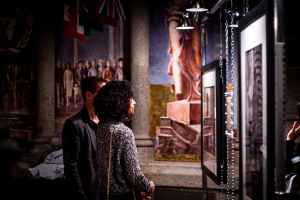I knew something special was about to happen when I walked up the stairs to the majestic Grace Cathedral in San Francisco. It was nearly dusk when I opened the front door and was ushered stage left into the world of Lost Childhoods.
Lost Childhoods, an exhibition of Foster Youth Museum, chronicles youth experiences in foster care. This traveling exhibition is revealing the voices of foster youth, all too often silenced through the heartaches of loss, and the powerlessness of institutionalization.
In the words of Ipo Ma’e, a former foster youth who spoke at the opening reception, “The museum is helping heal people like me and is giving our voices back.”
With artifacts, photos, art and video portraits, Foster Youth Museum is the largest collection of its kind, and both youth and the public are taking notice. During an Oakland, Calif., gallery exhibition, some 2,000 people viewed the exhibit over one month. At the historic Grace Cathedral in San Francisco, upwards of 6,000 will take part during its two-week run, October 15 to November 1. Admission is free, and it’s open daily from 9:00 a.m. to 6:00 p.m.

Guests view the exhibits at Lost Childhoods, a Foster Youth Museum production. Photo by Jeremiah McWright
Walking through the exhibit, I paused in front of a large black and white photo of Latrenda Leslie holding a clear plastic bag containing her belongings. This photo tells the story of “foster youth luggage,” into which foster youth place their scant belongings when moving between placements. Leslie says she wants you to “think about the instability foster youth experience.” And she wants you to know that “youth are strong and carry on, but they need your support.”
Rev. Marc Handley Andrus, Bishop of the Episcopal Diocese of California, welcomed 400 visitors to the opening, and said, “Grace Cathedral has never hosted anything more important than Lost Childhoods, which is putting a face on one of our most vulnerable populations: foster youth.”
California State Senator Mark Leno, who regularly introduces legislation supporting foster youth, said: “Foster youth are our youth, and we have to take full responsibility for their stories and experiences, and make sure the next generation has better experiences.”
Foster Youth Museum represents a new trend in museums, one that combines art and social justice. Art reaches people in ways that other efforts do not.
One display case features original diplomas. You might wonder why a youth who has so little and has worked so hard would let go of his or her graduation diploma – or any of the objects in the museum for that matter. Put simply, the museum is a vessel for healing.

Chris Chase and Rebecca Edwards of Braid Mission discuss Lost Childhoods. Photo by Jeremiah McWright
Rev. Rebecca Edwards can tell you what happens when you are moved by art and advocacy. Co-director of Braid Mission, primary exhibition sponsor, Edwards saw a private exhibition of Foster Youth Museum last year, and as a result, changed the direction of Braid to meet the needs of foster youth in San Francisco.
Zellerbach Family Foundation has also been instrumental in bringing Foster Youth Museum to the general public.
As visitors progress through themes of developmental disruption, institutionalization and loss, they begin to witness transformation. This part of the exhibition tells youth stories about healing and redemption; after all, the current and former foster youth who share their voices in the museum may have been “lost,” but they are indeed resilient.
Co-director Jamie Lee Evans shared the museum’s vision with attendees:
We would like every community to have access to Lost Childhoods because every time we show an exhibit of Foster Youth Museum, we are engaging communities in a conversation about what it means to support foster youth around housing, healthcare, education and connection.
While legislation changes policies, and child welfare training changes practices, art has the power to move the general public.
Foster Youth Museum is seeking funding to support a full-time staff member to bring exhibitions to communities throughout California and the United States, with wraparound events that engage the public in dialog about foster youth needs.





